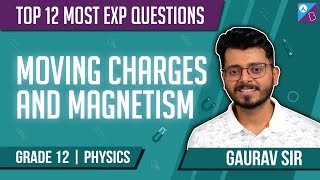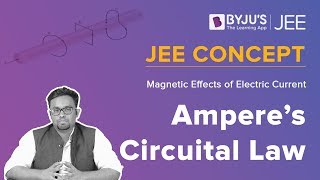For more than a century, moving charges and magnetism, i.e., electricity, have been explored. The phenomenon observed with the alignment of a needle was the origin of the relationship between the two. It was found that the alignment of the needle is tangent to an imaginary circle with a straight wire in the centre and a plane of the circle perpendicular to the wire. However, when the current is passed, the needle’s orientation shifts. The production of a magnetic field is thought to be caused by the passage of charges. The direction of deflection of the needle is given by Ampere’s swimming rule.
Table of Contents
- Ampere’s Swimming Rule
- Magnetic Field
- Motion of a Charged Particle in a Magnetic Field
- Biot-Savart Law
- Ampere’s Circuital Law
- Frequently Asked Questions
Ampere’s Swimming Rule
According to this rule, if a swimmer is imagined to swim along the conductor in the direction of the current, facing the needle, then the north pole of the needle is deflected to the left.
Magnetic Field
A stationary charge generates an electric field in its environment, and a moving charge generates a field in its environment that imposes a force on the moving charge. This field is referred to as the magnetic field, which is a vector quantity symbolised by the letter B. The nature of the magnetic field surrounding a conductor depends on the geometry of the conductor.
Motion of a Charged Particle in a Magnetic Field
Case 1: θ = 00 0r 1800
The path followed is a straight line.
As the angle between v and B is zero or 180°, a charged particle thrown parallel or antiparallel to a magnetic field will not experience any magnetic force. As a result, it will continue to travel in a straight line at a constant speed.
Case 2: θ = 900
The path followed is circular.
A charged particle’s path is a circle when projected perpendicular to a uniform magnetic field. The magnetic Lorentz force works as a centripetal force, causing the charged particle to move at a constant speed in a circular path of radius R.
F = qvB = mv2/R
⇒ R = mv/qB
Angular velocity (ω) = v/R = qB/m
Time period of revolution, T = 2π/ω = 2πm/qB
Frequency of revolution = 1/T = qB/2πm
Biot-Savart Law
Consider the conductor’s infinitesimal element ds. The magnetic field dB produced by this element must be measured at a location P, that is, at a distance r away from it. Let r be the position vector and θ be the angle between them. The direction of ds is the same as the current direction.

The magnitude of the magnetic field dB is directly proportional to the current I and the element length ds, and it is inversely proportional to the square of the distance r, according to the Biot-Savart law. The direction of the magnetic field is perpendicular to the direction of the plane containing ds and r.
When the medium is a vacuum, the above expression stands true.
Here, μ0 is the permeability of free space.
Ampere’s Circuital Law
According to Ampere’s circuital equation, the line integral of a steady magnetic field across a closed loop is equal to μ0 times the total current (Ie) travelling through the surface bounded by the loop.
Application of Ampere’s Circuital Law
Magnetic Field Due to a Straight Infinite Current-Carrying Wire

Consider a current-carrying wire that is infinitely straight. We make an Amperian loop, which is a circle with a radius of r and a wire at its axis. As the magnetic field is tangential at all points on the loop, at all places, the magnetic field is of similar magnitude.
Now, applying Ampere’s Law,
B(2πr) = μ0I
B = μ0I/2πr
Magnetic Field due to a Solenoid
A solenoid is a cylindrical coil made of several turns of wire. The wire is coated with an insulating material so that even if the turns touch each other, they are electrically insulated.
Generally, the length of the solenoid is much greater than the radius of the transverse section of the solenoid. When the turns of the solenoid are closely spaced, each turn can be considered as a circular coil, and the net magnetic field at any point is the vector sum of the fields due to all the turns.


If the turns are closely wound, and the length is much greater than the radius, then the solenoid is treated as an ideal solenoid. For such a solenoid, the field outside is weaker than that inside the solenoid. Further, the field inside is uniform over a considerable volume and is along the axis of the solenoid. The figure below depicts a section of a long solenoid with an ‘n’ number of turns.

Using the Ampere circuital law, we can find the field. Consider a rectangular loop ABCD where the integration direction is anti-clockwise. For this loop,
μ0I = B x a
If a solenoid has ‘n’ rounds of wire in a unit length, then the current is given by I = nai
Therefore, μ0(nai) = B x a
⇒ B = μ0(nai)/a
B = μ0(ni)
Magnetic Force
When a charge is at rest, it is observed to experience almost no force. The charge q, on the other hand, is deflected towards the wire if it is given a velocity v in the direction of the current. As a result, we can conclude that a moving charged particle is acted upon by a magnetic field. Lorentz Force is the result of the interaction of electric and magnetic forces on a point charge.
At a given time, t, consider a point charge q travelling with velocity v and positioned at position vector r. If there is an electric field E and a magnetic field B at that location, the force on the electric charge q is equal to
This force is called the Lorentz force.
Magnetic Force on a Current-Carrying Conductor
Assume a current-carrying conductor is put in a uniform magnetic field, and l and A are the length and cross-sectional area, respectively. The free electrons in the wire have a drift velocity vd that is opposite to the current direction. The force experienced by each electron
The total force experienced by the conductor is
The Force between Two Parallel Current-Carrying Wires
Currents i1 and i2 are carried in the same direction by two parallel wires. Each conductor creates a magnetic field at the other wire’s position. The other conductor is acted upon by this magnetic field. When current travels in the same direction across the conductors, they attract each other.

We’ll use the assumption that the conductors are infinitely long and calculate the force per unit length between them.
Let B1 be the magnetic fields due to the first conductors.
Force on a sector of length ‘l’ for conductor 2 is
Moving Coil Galvanometer
In a uniform radial magnetic field, a galvanometer consists of a coil with many turns free to rotate around a fixed axis. The coil is wound around a cylindrical soft iron core, allowing the field to remain radial in all coil positions.

When the current flows through the coil, a torque acts on it. A torque is defined as force multiplied by the perpendicular distance between the forces.
τ = F x b

The torque acting on the coil’s single-loop ABCD.
τ = Bilb (Where l x b is the coil’s area A)
As a result, the torque acting on the n turns coil is given by
τ = niAB
The coil rotates as a result of the magnetic torque, and the phosphor bronze strip twists. The spring S linked to the coil, in turn, provides a counter torque or restoring torque kθ, resulting in a constant angular deflection.
Under equilibrium condition, kθ = niAB
Where k is the spring’s torsional constant, which is the restoring torque per unit twist. A pointer linked to the spring indicates the deflection on the scale.
θ = (nAB/k)i
The quantity nAB / k is a constant for a given galvanometer.
Galvanometer as Ammeter
The galvanometer cannot be used as an ammeter to measure the current in a circuit on its own.
A galvanometer is a highly sensitive instrument. For a current of the order of μA, it gives a full-scale deflection. Since the galvanometer has high resistance, it will modify the value of the current in the circuit.

To solve these challenges, a small resistance rs, known as shunt resistance, is connected in parallel with the galvanometer coil, allowing the shunt to carry the majority of the current.
Vgalvanometer = Vshunt
IgRg = (I – Ig)S
S = (I – Ig)/Ig
Ig = [S/(S + Rg)]I
Ig ∝ I
The deflection in the galvanometer is proportional to the current passing through it.
θ = (1/G)Ig
θ ∝ Ig
Therefore, θ ∝ I
The galvanometer is connected in parallel with the shunt resistance. As a result, the effective resistance, which is the resistance of an ammeter, may be calculated as
Reff = RGS/(RG + S)
Galvanometer as Voltmeter
To use a galvanometer to determine the potential difference between two sections of a circuit, they must be connected in parallel to the circuit. Furthermore, it must take very little current; otherwise, the voltage measurement will cause a significant degree of disruption to the original setup. Normally, we try to minimise the disturbance caused by the measuring device to 1%. A large resistance R is connected in series with the galvanometer to ensure this.

G = Resistance of the galvanometer
R = Resistance connected in series
Let V volt represent the potential difference that the voltmeter will detect, and Ig represent the current. Therefore, the voltage between a and b is given by
V = IgR + IgG
= Ig (R + G)
⇒ R = (V/Ig) – G
This is the resistance that must be connected in series with the galvanometer in order to convert it into a voltmeter with a range of 0-V volts.
Video Lessons
Moving Charges and Magnetism Rapid Revision

Most Important Topics for JEE – Moving Charges and Magnetism

Top 15 Most Important Questions – Moving Charges and Magnetism

Force on a Current Carrying Conductor in a Magnetic Field

Biot-Savart’s Law

Important and PY JEE Questions – Moving Charges and Magnetism

Ampere’s Circuital Law

Frequently Asked Questions on Moving Charges and Magnetism
What is the magnetic effect of an electric current?
When a current flows through a conductor, a magnetic field is set up in the region surrounding the conductor. This effect is called the magnetic effect of an electric current.
Which law is used to determine the flux density of the magnetic field at a point due to the current element?
Laplace’s law or Biot-Savart’s law is used to find the flux density of the magnetic field at a point due to a current element.
What is a solenoid?
A solenoid is a cylindrical coil made of several turns of wire.
Comments